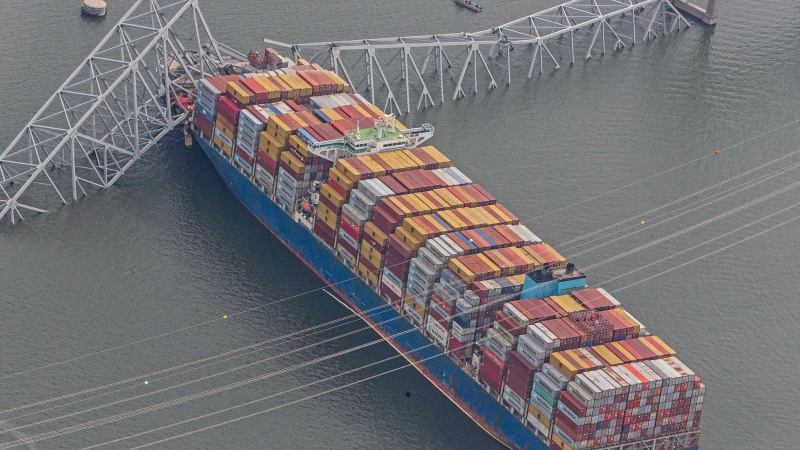Collapse of Baltimore's Key is latest bridge incident of 2024 after similar collisions in China, Argentina
Crews continued to search for the bodies of missing workers and federal officials were investigating Wednesday after the collapse of the Francis Scott Key Bridge in Baltimore, the third instance of a ship ramming into a bridge around the world this year.
The bridge collapsed into the Patapsco River early on Tuesday morning after a Singapore-flagged cargo ship named Dali collided with it.
Footage of the incident shows the cargo ship smash into one of the columns before the bridge snapped, hit the water and partially fell on the ship, where a burst of flames and smoke could be seen rising into the night sky.
A bridge collapse of this magnitude has not occurred in the U.S. in years, though it is far from the first such disaster. Globally, however, the Dali's collision is at least the third instance of a ship hitting a bridge this year after similar incidents in China and Argentina. Here's what to know about the collisions.
Follow along here for live updates →Search begins for bodies of missing workers after Francis Key Bridge collapse
February: Bridge partially collapses in China
Five people were killed and three others injured when part of the bridge over China’s Pearl River in Guangzhou collapsed after a container ship collided with the structure on Feb. 22.
Four vehicles and one electric motorcycle fell off the bridge after the collision. Those who were killed included a driver of an empty bus, the driver of the motorcycle and three people in trucks that went into the river, according to city officials.
“Improper operations” by the ship’s crew caused the collision, according to officials at the city’s press conference.
The container ship Lianghui 688 collided with the Lixinsha Bridge twice while navigating through the waterway. The city official said the ship hit adjacent bridge piers, leading to the rupture of the bridge deck over the space between the piers.
Based on reports obtained by online news platform Jimu News, the ship measured about 197 feet in length and 59 feet in height and transmitted its final position around 5:29 a.m. on Feb. 22.
Weibing Peng, an expert on bridge construction and collapse incidents from Zhejiang University of Technology analyzed the incident and told Jimu News that the ship first hit one pier on a diagonal course, then swung nearly parallel to the bridge and hit a second pier. The second pier tilted, resulting in the partial collapse of the bridge.

January: Bridge holds after ship collision in Argentina
In January, a cargo ship collided with the Zárate-Brazo Largo Bridges crossing the Prana River in Argentina, CNN reported citing Télam, a now-shuttered government-run news agency.
The Parana River waterway was shut down on Jan. 28, after a large bulker struck a support pillar of the Zárate-Brazo Largo bridge, Merco Press, a Uruguay-based media company reported.
The Liberian-flagged freighter “En May” had rudder problems which caused the helmsman to lose control and collide with the bridge pillar, maritime media outlet Paraguay Fluvial reported.
The Argentina's Coast Guard (PNA), told the Merco Press that the ship was around 750 feet long and was heading for San Lorenzo in the northeast part of the country. It was coming from Singapore.
It would take nearly a week to free the ship from the bridge and resume traffic, the Merco Press reported.
Why did the Francis Scott Key bridge collapse?
The bridge collapsed after the Dali slammed into one of its main support columns.
Bridges work by transferring the load they carry ‒ cars, trucks or trains ‒ through their support beams onto columns or piles sunk deep into the ground. They also depend on those support columns to hold them up.
“You go frame by frame in the video and you can see the support removed, and then as you watch, the entire structure comes down," Benjamin W. Schafer, a civil engineering professor at Johns Hopkins University in Baltimore told USA TODAY. “Literally the whole bridge comes down as a rigid body.”
Though modern bridges are typically designed so a small failure in one area doesn’t "propagate" to the entire bridge, steel-truss structures, like the Francis Scott Key Bridge are particularly at risk. One study found that more than 500 steel-truss bridges in the United States collapsed between 1989 and 2000.
Disclaimer: The copyright of this article belongs to the original author. Reposting this article is solely for the purpose of information dissemination and does not constitute any investment advice. If there is any infringement, please contact us immediately. We will make corrections or deletions as necessary. Thank you.






